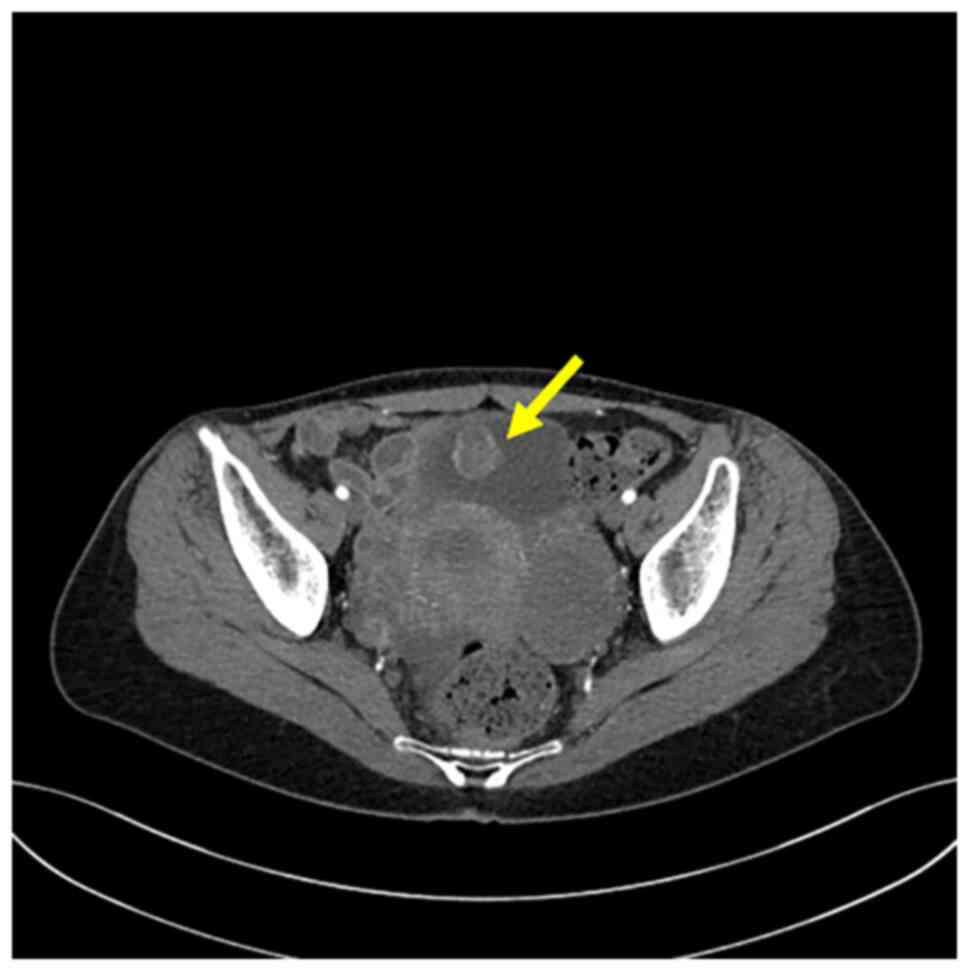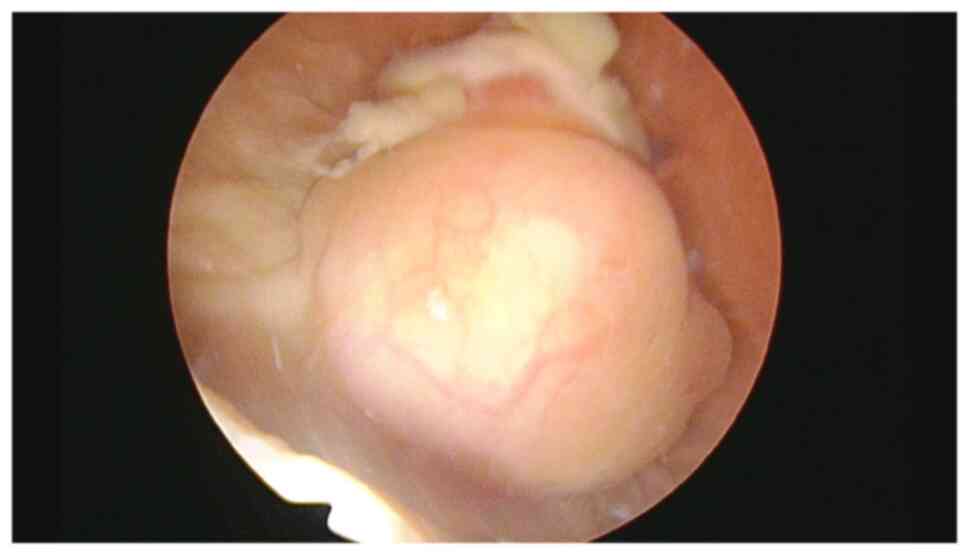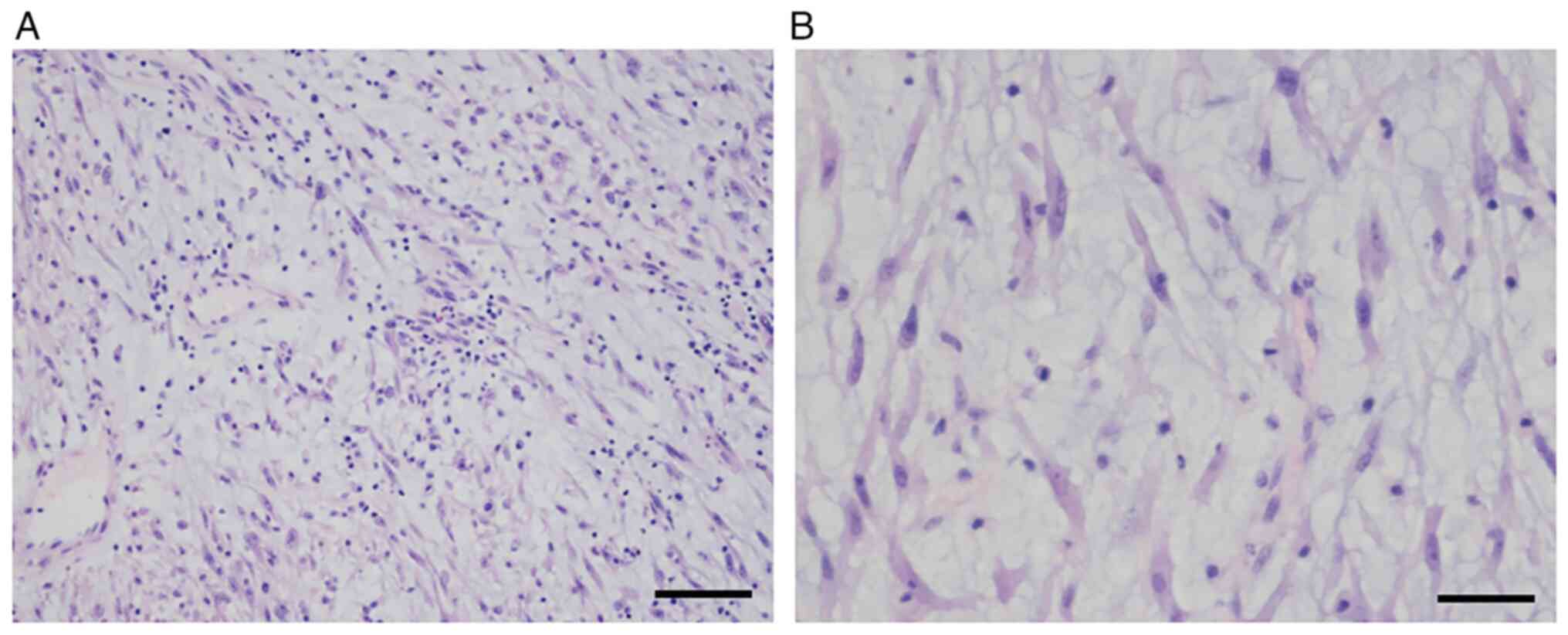|
1
|
Gleason BC and Hornick JL: Inflammatory
myofibroblastic tumours: Where are we now? J Clin Pathol.
61:428–437. 2008. View Article : Google Scholar : PubMed/NCBI
|
|
2
|
Coffin CM, Hornick JL and Fletcher CD:
Inflammatory myofibroblastic tumor: Comparison of
clinicopathologic, histologic, and immunohistochemical features
including ALK expression in atypical and aggressive cases. Am J
Surg Pathol. 31:509–520. 2007. View Article : Google Scholar : PubMed/NCBI
|
|
3
|
Lovly CM, Gupta A, Lipson D, Otto G,
Brennan T, Chung CT, Borinstein SC, Ross JS, Stephens PJ, Miller VA
and Coffin CM: Inflammatory myofibroblastic tumors harbor multiple
potentially actionable kinase fusions. Cancer Discov. 4:889–895.
2014. View Article : Google Scholar : PubMed/NCBI
|
|
4
|
Coffin CM, Patel A, Perkins S,
Elenitoba-Johnson KS, Perlman E and Griffin CA: ALK1 and p80
expression and chromosomal rearrangements involving 2p23 in
inflammatory myofibroblastic tumor. Mod Pathol. 14:569–576. 2001.
View Article : Google Scholar : PubMed/NCBI
|
|
5
|
Butrynski JE, D'Adamo DR, Hornick JL, Dal
Cin P, Antonescu CR, Jhanwar SC, Ladanyi M, Capelletti M, Rodig SJ,
Ramaiya N, et al: Crizotinib in ALK-rearranged inflammatory
myofibroblastic tumor. N Engl J Med. 363:1727–1733. 2010.
View Article : Google Scholar : PubMed/NCBI
|
|
6
|
Acosta AM, Demicco EG, Dal Cin P, Hirsch
MS, Fletcher CDM and Jo VY: Pseudosarcomatous myofibroblastic
proliferations of the urinary bladder are neoplasms characterized
by recurrent FN1-ALK fusions. Mod Pathol. 34:469–477. 2021.
View Article : Google Scholar : PubMed/NCBI
|
|
7
|
Ouchi K, Miyachi M, Tsuma Y, Tsuchiya K,
Iehara T, Konishi E, Yanagisawa A and Hosoi H: FN1: A novel fusion
partner of ALK in an inflammatory myofibroblastic tumor. Pediatr
Blood Cancer. 62:909–911. 2015. View Article : Google Scholar : PubMed/NCBI
|
|
8
|
Haimes JD, Stewart CJR, Kudlow BA, Culver
BP, Meng B, Koay E, Whitehouse A, Cope N, Lee JC, Ng T, et al:
Uterine inflammatory myofibroblastic tumors frequently harbor ALK
fusions with IGFBP5 and THBS1. Am J Surg Pathol. 41:773–780. 2017.
View Article : Google Scholar : PubMed/NCBI
|
|
9
|
Reinhart S, Trachsel Y, Fritz C, Wagner U,
Bode-Lesniewska B, John H and Pless M: Inflammatory myofibroblastic
tumor of the bladder with FN1-ALK gene fusion: Different response
to ALK inhibition. Urology. 146:32–35. 2020. View Article : Google Scholar : PubMed/NCBI
|
|
10
|
Antonescu CR, Suurmeijer AJ, Zhang L, Sung
YS, Jungbluth AA, Travis WD, Al-Ahmadie H, Fletcher CD and Alaggio
R: Molecular characterization of inflammatory myofibroblastic
tumors with frequent ALK and ROS1 gene fusions and rare novel RET
rearrangement. Am J Surg Pathol. 39:957–967. 2015. View Article : Google Scholar : PubMed/NCBI
|
|
11
|
Bertz S, Stohr R, Gaisa NT, Wullich B,
Hartmann A and Agaimy A: TERT promoter mutation analysis as a
surrogate to morphology and immunohistochemistry in problematic
spindle cell lesions of the urinary bladder. Histopathology.
77:949–962. 2020. View Article : Google Scholar : PubMed/NCBI
|
|
12
|
WHO Classification of Tumours Editorial
Board, . Urinary and male genital tumours. International Agency for
Research on Cancer. 8. 5th edition. WHO Classification of tumours
series; Lyon: 2022
|
|
13
|
Montgomery EA, Shuster DD, Burkart AL,
Esteban JM, Sgrignoli A, Elwood L, Vaughn DJ, Griffin CA and
Epstein JI: Inflammatory myofibroblastic tumors of the urinary
tract: A clinicopathologic study of 46 cases, including a malignant
example inflammatory fibrosarcoma and a subset associated with
high-grade urothelial carcinoma. Am J Surg Pathol. 30:1502–1512.
2006. View Article : Google Scholar : PubMed/NCBI
|
|
14
|
Coffin CM, Watterson J, Priest JR and
Dehner LP: Extrapulmonary inflammatory myofibroblastic tumor
(inflammatory pseudotumor). A clinicopathologic and
immunohistochemical study of 84 cases. Am J Surg Pathol.
19:859–872. 1995. View Article : Google Scholar : PubMed/NCBI
|
|
15
|
Cook JR, Dehner LP, Collins MH, Ma Z,
Morris SW, Coffin CM and Hill DA: Anaplastic lymphoma kinase (ALK)
expression in the inflammatory myofibroblastic tumor: A comparative
immunohistochemical study. Am J Surg Pathol. 25:1364–1371. 2001.
View Article : Google Scholar : PubMed/NCBI
|
|
16
|
Teoh JY, Chan NH, Cheung HY, Hou SS and Ng
CF: Inflammatory myofibroblastic tumors of the urinary bladder: A
systematic review. Urology. 84:503–508. 2014. View Article : Google Scholar : PubMed/NCBI
|
|
17
|
Inamura K, Kobayashi M, Nagano H, Sugiura
Y, Ogawa M, Masuda H, Yonese J and Ishikawa Y: A novel fusion of
HNRNPA1-ALK in inflammatory myofibroblastic tumor of urinary
bladder. Hum Pathol. 69:96–100. 2017. View Article : Google Scholar : PubMed/NCBI
|
|
18
|
Hisaoka M, Shimajiri S, Matsuki Y,
Meis-Kindblom JM, Kindblom LG, Li XQ, Wang J and Hashimoto H:
Inflammatory myofibroblastic tumor with predominant anaplastic
lymphoma kinase-positive cells lacking a myofibroblastic phenotype.
Pathol Int. 53:376–381. 2003. View Article : Google Scholar : PubMed/NCBI
|
|
19
|
Debiec-Rychter M, Marynen P, Hagemeijer A
and Pauwels P: ALK-ATIC fusion in urinary bladder inflammatory
myofibroblastic tumor. Genes Chromosomes Cancer. 38:187–190. 2003.
View Article : Google Scholar : PubMed/NCBI
|
|
20
|
Lygoe KA, Wall I, Stephens P and Lewis MP:
Role of vitronectin and fibronectin receptors in oral mucosal and
dermal myofibroblast differentiation. Biol Cell. 99:601–614. 2007.
View Article : Google Scholar : PubMed/NCBI
|
|
21
|
Mano H: ALKoma: A cancer subtype with a
shared target. Cancer Discov. 2:495–502. 2012. View Article : Google Scholar : PubMed/NCBI
|
|
22
|
Ren H, Tan ZP, Zhu X, Crosby K, Haack H,
Ren JM, Beausoleil S, Moritz A, Innocenti G, Rush J, et al:
Identification of anaplastic lymphoma kinase as a potential
therapeutic target in ovarian cancer. Cancer Res. 72:3312–3323.
2012. View Article : Google Scholar : PubMed/NCBI
|
|
23
|
Marino-Enriquez A and Dal Cin P: ALK as a
paradigm of oncogenic promiscuity: Different mechanisms of
activation and different fusion partners drive tumors of different
lineages. Cancer Genet. 206:357–373. 2013. View Article : Google Scholar : PubMed/NCBI
|
|
24
|
Childress MA, Himmelberg SM, Chen H, Deng
W, Davies MA and Lovly CM: ALK Fusion partners impact response to
ALK Inhibition: Differential effects on sensitivity, cellular
phenotypes, and biochemical properties. Mol Cancer Res.
16:1724–1736. 2018. View Article : Google Scholar : PubMed/NCBI
|
|
25
|
Testa S, Million L, Longacre T and Bui N:
Uterine leiomyosarcoma with FN1-Anaplastic lymphoma kinase fusion
responsive to alectinib and lorlatinib. Case Rep Oncol. 14:812–819.
2021. View Article : Google Scholar : PubMed/NCBI
|


















